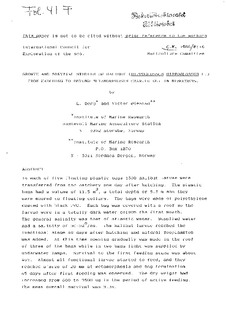Growth and survival studies of halibut (Hippoglossus hippoglossus L.) from hatching to beyond metamorphosis carried out in mesocosms
Working paper
Permanent lenke
http://hdl.handle.net/11250/104147Utgivelsesdato
1986Metadata
Vis full innførselSamlinger
Originalversjon
This report is not to be cited without prior reference to the authorsSammendrag
To each of five floating plastic bags 1500 halibut larvae were
transferred from the hatchery one day after hatching. The plastic bags had a volume of 11.5 m3, a total depth of 5.5 m and they
were moored to floating collars. The bags were made of polyethylene
coated with black PVC. Each bag was covered with a roof so the
larvae were in a totally dark water column the first month.
The general salinity was that of Atlantic water. Supplied water had a salinity of 30-32 o/oo. The halibut larvae reached the
functional stage 40 days after hatching and natural zooplankton
was added. At this time opening gradually was made in the roof
of three of the bags while in two bags light was supplied by
underwater lamps. Survival to the first feeding stage was about
45%. Almost all functional larvae started to feed, and they
reached a size of 20 mm at metamorphosis and bag termination
45 days after first feeding was observed. The dry weight had
increased from 600 to 3500 ug in the period of active feeding.
The mean overall survival was 3.3%.
